Google Nexus 9: Preliminary Findings
by Joshua Ho on November 3, 2014 1:00 PM ESTGPU Performance
Following along the same lines, we can also take a look at the GPU performance of Tegra13x in the Nexus 9. This really shouldn’t change too much though as the same GPU is used at the same maximum clock speed of 852 MHz. For those that are unfamiliar with the GPU in the Tegra K1, this is effectively a scaled-down version of their desktop Kepler GPUs.

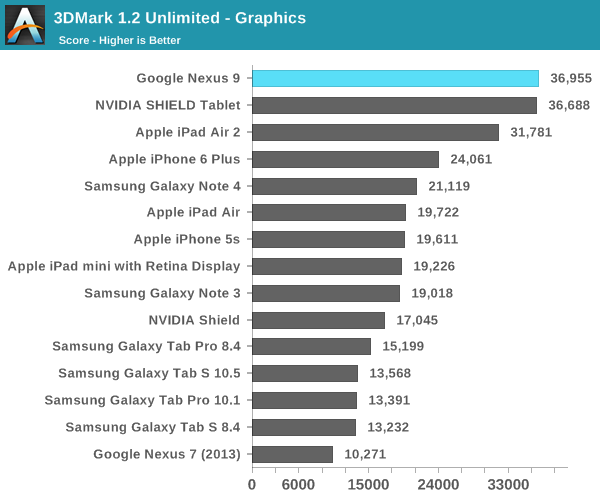
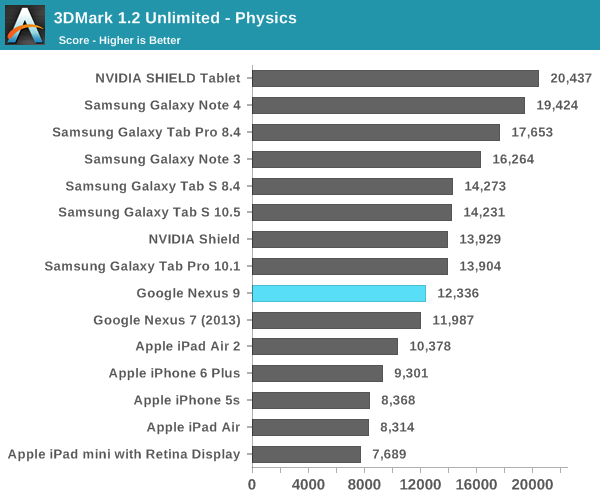
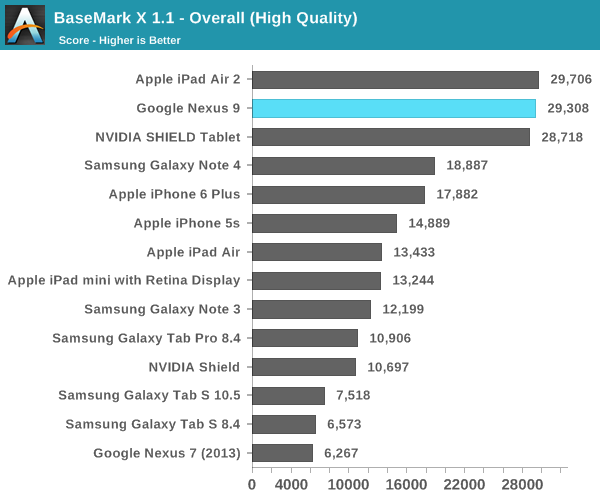
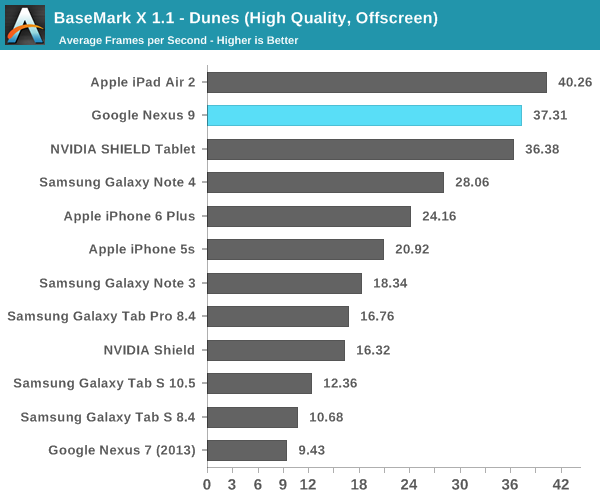
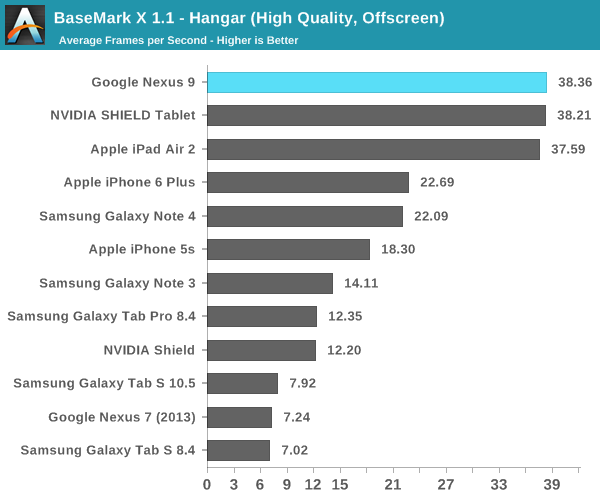
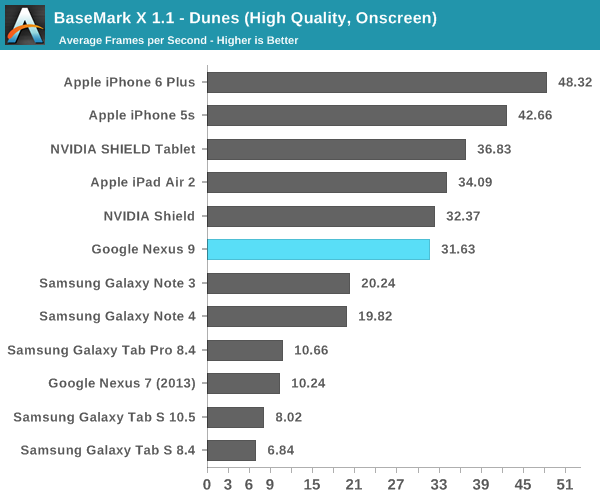

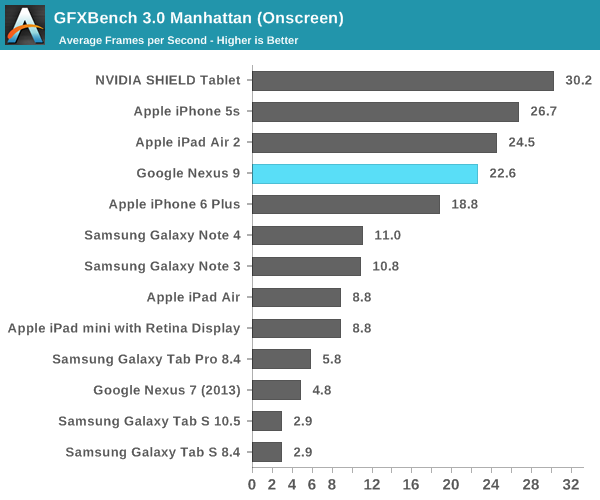
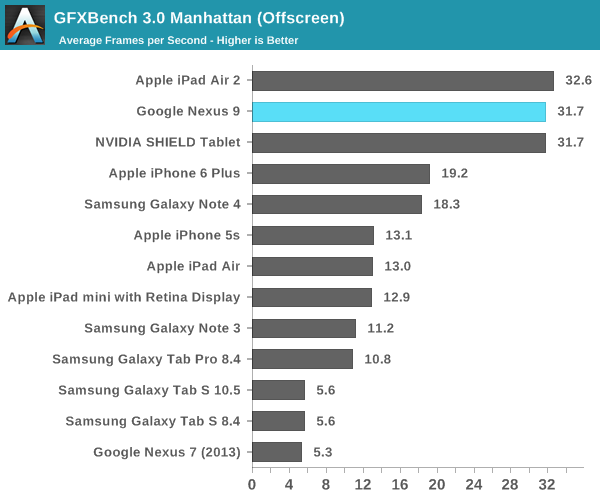
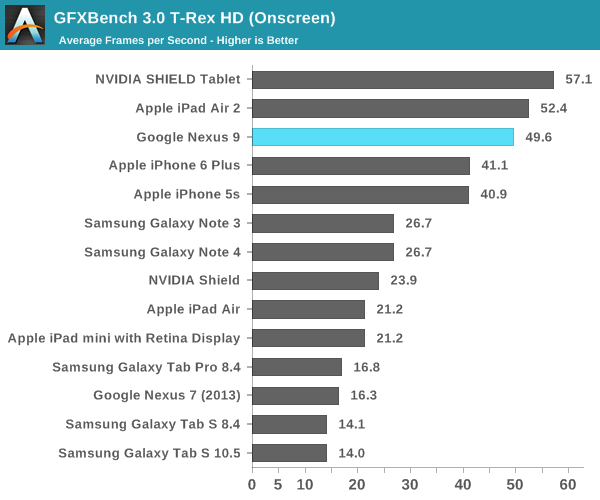
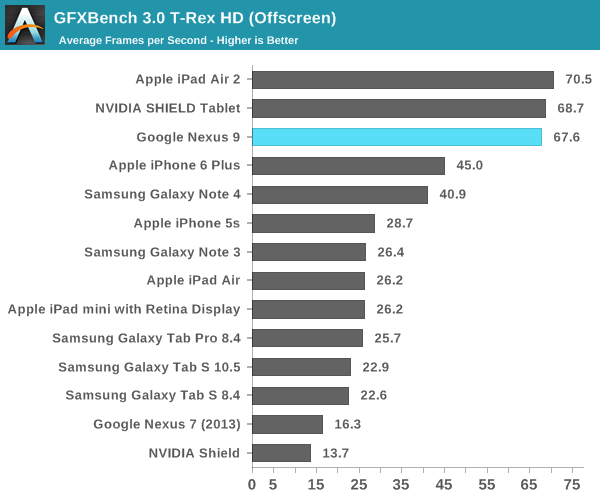
As one can see, the Nexus 9 is effectively equivalent to the SHIELD Tablet in GPU performance. The one anomaly here is 3DMark, which seems to be mostly due to differences in CPU. It's likely that this isn't representative of performance though, as 3DMark's physics test seems to perform better on CPU configurations that rely on larger numbers of cores and higher clock speeds. In the purer GPU tests like Basemark X and GFXBench performance across the board is effectively identical to the Cortex A15 variant of the Tegra K1.
Initial Conclusions
For the most part, the Nexus 9 shows some level of promise as a tablet. While Denver in NVIDIA’s Tegra K1 is a bit bimodal in performance, with sufficient optimization it has immense promise from a sheer performance aspect. While the SoC alone makes the Nexus 9 a fascinating device to look at, the rest of the package has a great deal of potential. The minimalistic design of the device, combined with good material design and stereo front-facing speakers really shows the high-end aspirations of this tablet. While we haven't received anything in the way of accessories, the keyboard folio case seems to be a way of pushing the tablet formfactor in a new direction. This is especially evident when seeing the focus on previous Nexus tablets which seemed to assume touch-only input.
While only a first look, there’s definitely a lot to be impressed by here. However, it will take a full review to really determine whether the Nexus 9 can compete with the iPad Air 2 as a tablet is more than just a function of battery life and SoC performance. In addition, it's hard to draw any real conclusions about this tablet quite yet as the software we received in no way represents a shipping build. Even if inactive, loggers and debug tools generally reduce performance, and it's likely that a great deal of optimization has occurred in the two months since this software build was completed. Once again, we haven't been able to get a newer build, but the full review should be done with shipping firmware.










146 Comments
View All Comments
GC2:CS - Monday, November 3, 2014 - link
The question is simple, at what power denver matches the A8X ?If we take the K1 GPU story, we see that Apple has a "bit" lower target for TDP at which the SoC starts to throttle.
Even my two year old laptop is faster than A8X but I didn't saw anyone being interested in that.
chizow - Monday, November 3, 2014 - link
Is your two year old laptop 6-8mm deep and last ~10 hours on 1 battery charge? Then why bother mentioning it.We see in the review, Nexus 9 actually has slightly better battery life than A8X, so I'd say it matches A8X now at current TDP which is estimated on all these SoCs to be about 4.5W. With the benefit of 20nm it would undoubtedly beat A8X either via more transistors (as Apple did) or higher clockspeeds.
mkozakewich - Monday, November 3, 2014 - link
Yeah, what he's saying is that the raw performance doesn't matter if it's not taken in context with the size and battery life and such. He's arguing the same thing as you.chizow - Monday, November 3, 2014 - link
Uh, no except he was comparing two devices in the same class with similar form factors with a 3 year old laptop that is probably 5x thicker with 1/5th the battery life. If he was trying to draw parallels he did an exceptionally poor job at doing so. How is comparing the performance of the Nexus 9 to iPad Air 2 SoCs the same as trying to draw a similar comparison with a 3 year old laptop? Everything that makes the tablet interesting goes out the window on something in that huge clunky form factor.Alexvrb - Monday, November 3, 2014 - link
He was clearly exaggerating to make a point. Performance doesn't everything by itself, especially in situations like this. The A8X is a good chip, and it's more efficient than Denver. Give Denver a die shrink and the tables should turn.chizow - Tuesday, November 4, 2014 - link
He made a pointless point I guess then, because the A8X and K1 are very close in terms of performance and efficiency to the point I'm not sure anyone could make an accurate assessment based on what we know.Air 2 has a bigger screen, but the N9's screen is brighter.
Air 2 has a bigger battery, and the N9 has better battery life.
So again, how exactly do you know the A8X is more efficient than Denver?
DERSS - Wednesday, November 5, 2014 - link
Just look at manufacturing norms. Wonders belong to magic farytales, hard reality tells that 20 nm is much more energy efficient than 28 nm.As result, on heavy load NVidia K1 Denver will fall dramatically, if the load is prolonged. There is no other way, because otherwise battery life under load would be drastically lower than on iPad Air 2.
Alexvrb - Friday, November 7, 2014 - link
So, before you evangelize Nvidia products, do you actually read the articles?"As always, our battery life tests are all run with the display calibrated to 200 nits."
Anandtech has been doing this very same procedure for a long time.
tuxRoller - Tuesday, November 4, 2014 - link
The N9 has essentially the same battery life as the larger screened (larger power draw), smaller battery ipad.The ipad is also using much lower clocks on their cpu, and their gpu looks to be at least a match to the tk1.
Apple is on 20nm, and that's a big deal, but performance doesn't change things significently.
Pretty dissapointed with this nvidia effort.
Hoping from more with the upcoming cortex a57.
kron123456789 - Tuesday, November 4, 2014 - link
Well, iPad's battery is larger. And Cortex A57 is already here - Galaxy Note 4.